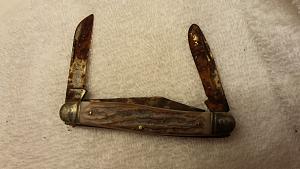After a year in the woods covered up with leaves. My brother in law and I went back to the blind area I hunted from last year with a metal detector and a leaf rake. We found it in five minutes flat!
However it is a carbon steel Camillius that is now badly rusted. What is the best thing to clean this up with? I was thinking a long soak in turpentine or kerosene, then polishing with a dremel polishing wheel.
Any better thoughts. I want this back in my pocket. I bought it in 1978 and it takes a razor keen edge.


|
   
   
|


|







 Reply With Quote
Reply With Quote























